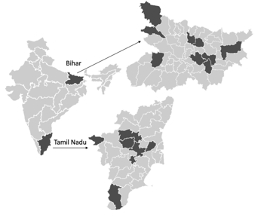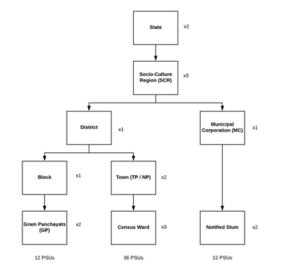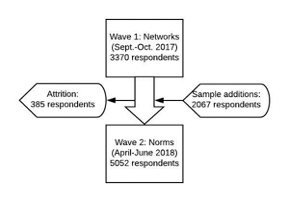The Longitudinal Evaluation of Networks and Norms Study (LENNS) in India
Why was the study set up?
The Longitudinal Evaluation of Network and Norms Study (LENNS) was established in partnership and with the financial support of the Bill and Melinda Gates Foundation in order to study the social patterns of open defecation in India and find cost-effective ways to promote latrine use. The sample includes individuals from two states of India with drastically different levels of development, a relatively more developed state of Tamil Nadu and one of the least developed states of India, Bihar, which, despite their differences, are both facing similar struggles with lowering open defecation rates. To address the diverse nature of constraints people face when adopting better sanitation practices in different geographic contexts, we stratify our sample by urbanicity. The study was established in 2016 with two waves of data collection happening in 2017 and 2018. These two waves constitute a part of formative research for the behavior change intervention targeted at promoting latrine use, that will happen throughout 2020. The data collection was approved by the Institutional Review Board (IRB) at the University of Pennsylvania and, in India, by the Center for Media Studies IRB (CMS-IRB).
Who is in the study?
The LENNS is based in two states of India, Bihar in the North-West and Tamil Nadu in the South. To better capture the diversity of the population in the states, they were further stratified into subdivisions based on prior work of our subcontractors in India and informally referred to as Socio-Cultural Regions (SCR). From each of these SCRs, one or more districts were randomly selected depending on the availability of settlement types included in the study. We then stratified the sample into three types of settlements, rural Gram Panchayats (GP), notified slums in Municipal Corporations (MC), and wards in small towns (Town Panchayats in Tamil Nadu and Nagar Panchayats in Bihar (TP/NP)), a settlement type in transition from rural to urban status. Individuals living outside these geographies were not included in the sampling strategy (this group includes individuals living in municipalities as well anyone in municipal corporations who does not reside in notified slums).
For the rural sample, one community development block was chosen randomly from the list of blocks in each selected district. Within this block, one GP was chosen at random and another GP was matched with it based on socio-economic characteristics including population size and proportion of individuals in Scheduled Caste and Scheduled Tribe groups, proportion of illiterate individuals, total number of laborers, and the number of households with latrines based on the 2011 Census figures.
Similarly, for the TP/NP sample, two towns were chosen from the same district. From the selected towns, three census wards were randomly selected and surveyed.
For the sample of slums, we select one MC randomly from each of the SCRs. From the selected MCs, we randomly choose two notified slums, defined as all notified areas in a town or city notified as ‘Slum’ by a government authority. We prioritized selecting MCs from the same district used for sampling of other types of settlement. However, when a district lacked MCs, adjacent districts were sampled for this purpose.
The location of the primary sampling units is presented in Figure 1 below. The survey thus does not include individuals living in unnotified slums. Due to the transient and unofficial nature of these slums, we expect them to be different from the ones in our sample, and this is an important limitation of our study.

Figure 1: Location of districts with sampled primary sampling units In Bihar and Tamil Nadu.
After the areas are selected for the survey, a complete listing of households in the selected areas was conducted prior to the selection of individuals. The listing workflow consisted of visiting each of the selected Primary Sampling Units (PSU), drawing a sketch map of the structures in the PSU, and then recording every individual in all the households in the PSU with the names of the heads of the households and ages of all eligible individuals. Figure 2 here presents the schematic representation of the sampling strategy.

Figure 2: LENNS Sampling Strategy
Selection of individuals
For the purposes of this study, eligible respondents were defined as individuals in the ages 16 to 65 living in the sampled PSUs willing and able to participate in the study. The initial list of respondents was randomly selected from the listings and interviewers attempted to reach each respondent three times at different times of the day. If the respondent was not available or unwilling to answer the questions, another respondent from the PSU was randomly selected until the desired sample size was reached.
How often are they followed up? What is the attrition like?
Figure 3 below presents the sample flow of the study. We first interviewed 3370 respondents in September – November of 2017 and asked them about their social networks. In April – June of 2018 we conducted a second wave of the study and interviewed all the respondents from the first wave we could reach and 2452 new respondents in order to better understand the nature of social norms surrounding open defecation in India. We were unable to reach 385 of the original 3370 respondents. We were unable to collect reliable information on the reasons behind attrition, but during the debriefing with the survey team unwillingness to spend a few hours on the interview was brought up frequently. Additionally, particularly in Tamil Nadu, some of the respondents migrated to a different area or were traveling for work. Finally, the second wave coincided with the wedding season, due to which many of the female respondents were away from their homes.

Figure 3: LENNS Sample Flow
Data Collected
Table 1 contains information on the types of measurements collected during the study. Demographic and socioeconomic characteristics, as well as information about defecation behavior and available sanitation facilities were collected in both waves of the survey, albeit the exact measurements differed slightly between waves. Wave 1 additionally asked respondents an extensive set of questions about their social ties following an egocentric approach(Campbell and Lee 1991). We collected information on who individuals contact in times of financial hardships, who they respect the most, and who they talk to about toilets and ask for help with sanitation facilities to capture the variety of social situations individuals engage in (Shakya, Christakis, and Fowler 2017). We also ask individuals a set of questions about their place-based networks, types of events they attend and their membership in various local groups (Fujimoto 2012). In wave 2, we ask an extensive set of questions about the respondents’ factual beliefs about various aspects of sanitation behavior as well as about social norms surrounding sanitation practices following the approach developed by C. Bicchieri (Bicchieri 2006; Bicchieri 2016). Detailed questionnaires are available through the website of PENN SoNG.
LENNS content
| Wave | Domain | Measurements |
| Both waves | Demographics and Household composition | Age, gender, occupation, level of education, migration history, ethnicity, social class, religion, workplace, usual living place, usual defecation places, latrine access of respondents and other household members |
| Household Characteristics | Quality of housing including current tenure type, assets ownership (land, latrine, electricity, drinking water access, have separate room as kitchen etc.) | |
| Health and Wellbeing | Life satisfaction, self-rated health, food scarcity, changes in health condition, perceived consequences of using latrine or defecating in the open, perceived reasons for diarrhea | |
| Defecation behavior | Latrine preferences; defecation behavior, other people’s defecation choice and reasons; characteristics of open defecation place and behavior, whether accompanied by others, public or community latrine accessibility | |
| Sanitation Facility | Self-reported latrine characteristics including type, number, whether have flush, fecal storage, slab, pits; household latrine construction decision including who and why make the decision, who dig the pit, latrine construction financing and whether get help from the mason; latrine maintenance including who empty the pit, how will it be emptied, the cost of pit emptying | |
| Observation of Resident and Sanitation Facility | Materials of house, wall, roof; latrine location, type and characteristics including whether have flush, slab, functional pan-pipe-pit connection, water seal, feces/urine odor, stool, insects | |
| Wave 1 | Name Generator | Individuals that respondent can ask for advice and help for building latrine, cleaning latrine, when experiencing crisis, have conversations with about defecation behavior, and who respondent respect (up to 5 name generated for each question domain) |
| Social Network | Demographic information of named individual in previous section including age, occupation, social groups, religion, ethnicity; type and pattern of contact including relationship, contact frequency, wealth comparison, talk about latrine(e.g., available toilet models, masons, latrine cost, latrine financing, getting help from the government, opinion of defecating behavior) | |
| Community Interaction | Membership in community groups and political parties, frequency of social interaction, latrine education in school, past intervention in community, respected person within community | |
| Wave 2 | Social Norm | Behavior, empirical expectation, personal normative belief and normative expectation about open defecation, latrine usage, latrine location, household latrine construction decision, women going to defecation openly alone, women use public latrine, men use household latrine and pit empty by non-Dalits |
| Factual Belief | Time for a pit to fill, content character of pit upon fill, consequence of pit-emptying, cost of building a latrine, whether latrine will contaminate drinking water, health effect of open defecation or using a latrine, quality of government constructed latrine, getting government help to build a latrine |
Data Resource Use
A publication list for LENNS is available at https://pennsong.sas.upenn.edu/literature/. Here we present some of the preliminary findings of the group.
Data Resource Access
Public use anonymized version of the LENNS data is available for researchers upon request. Researchers interested in using the data are encouraged to submit a proposal (including the analysis and IRB plan) to the LENNS through the official website of PENN SoNG. Eventually we plan to release the public version of the data through a third-party data repository.
Funding
The LENNS surveys were funded by the Bill and Melinda Gates Foundation (Grant opportunity number: OPP1157257).
Acknowledgement
We wish to thank Bill and Melinda Gates foundation for their generous support. We received valuable feedback from the participants in the 2018 and 2019 Milestone Workshops in Delhi, India. We also would like to acknowledge the assistance of Kantar Public and their surveyors in data collection. We benefited throughout the preparation process from the generous comments of Doug Paletta. We would not be able to succeed in this project without the commitment and dedication of our research assistants and consultants.
Finally, we thank the participants themselves for their time.
References
- Campbell, Karen E., and Barrett A. Lee. 1991. “Name Generators in Surveys of Personal Networks”. Social Networks 13 (3): 203–21. https://doi.org/10.1016/0378-8733(91)90006-f.
- Shakya, Holly B., Nicholas A. Christakis, and James H. Fowler. 2017. “An Exploratory Comparison of Name Generator Content: Data from Rural India”. Social Networks 48 (January): 157–68. https://doi.org/10.1016/j.socnet.2016.08.008.
- Fujimoto, Kayo. 2012. “Using Mixed-Mode Networks to Disentangle Multiple Sources of Social Influence”. In Social Computing Behavioral – Cultural Modeling and Prediction, 214–21. Springer Berlin Heidelberg. https://doi.org/10.1007/978-3-642-29047-3_26.
- Bicchieri, Cristina. 2005. The Grammar of Society. Cambridge University Press.
- Bicchieri, Cristina. 2016. Norms in the Wild: How to Diagnose, Measure, and Change Social Norms. Oxford University Press.
- Doron, Assa, and Robin Jeffrey. 2014. “Open Defecation in India”. Econ Pol Wkly 49 (49): 72–78.
